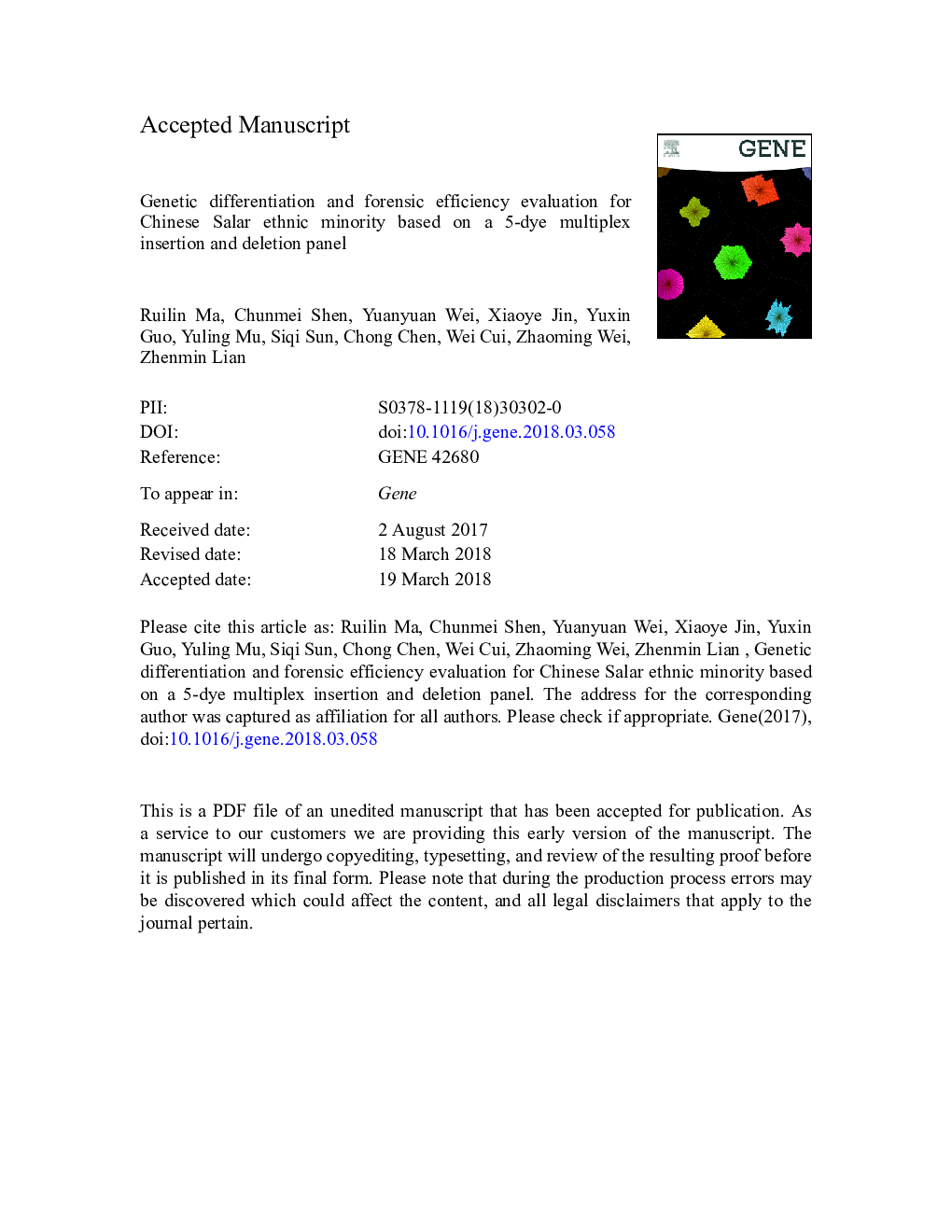| کد مقاله | کد نشریه | سال انتشار | مقاله انگلیسی | نسخه تمام متن |
|---|---|---|---|---|
| 8645152 | 1569776 | 2018 | 38 صفحه PDF | دانلود رایگان |
عنوان انگلیسی مقاله ISI
Genetic differentiation and forensic efficiency evaluation for Chinese Salar ethnic minority based on a 5-dye multiplex insertion and deletion panel
ترجمه فارسی عنوان
تمایز ژنتیکی و ارزیابی کارایی قانونی برای اقلیت قومی سلطنتی چین براساس پانل قرار دادن و حذف چندگانه 5 رنگ
دانلود مقاله + سفارش ترجمه
دانلود مقاله ISI انگلیسی
رایگان برای ایرانیان
کلمات کلیدی
CPEHWETPIInDelPICSNPsCDPPCA - PCASTRs - STRSprobability of exclusion - احتمال خروجMatch probability - احتمال مسابقهPrincipal components analysis - تجزیه و تحلیل اجزای اصلیShort tandem repeats - تداوم کوتاه مدتHardy-Weinberg equilibrium - تعادل هاردی-وینبرگinsertion and deletion - درج و حذفLinkage disequilibrium - عدم تعادل پیوستگیDiscrimination power - قدرت تبعیضpolymorphism information content - محتوای اطلاعات پلی مورفیسمobserved heterozygosity - مشاهده هتروزیگوتیسمexpected heterozygosity - هتروزیگوتاسیون انتظار می رودSingle nucleotide polymorphisms - پلیمورفیسم تک نوکلئوتیدیForensic genetics - ژنتیک قانونی
موضوعات مرتبط
علوم زیستی و بیوفناوری
بیوشیمی، ژنتیک و زیست شناسی مولکولی
ژنتیک
چکیده انگلیسی
The present study investigated the genetic diversities of 30 autosomal insertion and deletion (InDel) loci of Investigator DIPplex kit (Qiagen) in Chinese Salar ethnic minority and explored the genetic relationships between the studied Salar group and other populations. The allelic frequencies of deletion alleles at the 30 InDel loci were in the range of 0.1739 (HLD64) to 0.8478 (HLD39). The discrimination power, polymorphism information content and probability of exclusion ranged from 0.4101 (HLD39) to 0.6447 (HLD136), 0.2247 (HLD39) to 0.3750 (HLD92) and 0.0400 (HLD39) to 0.2806 (HLD92), respectively. The observed and expected heterozygosity were in the range of 0.2348 (HLD39) to 0.5913 (HLD92), and 0.2580 (HLD39) to 0.5000 (HLD92), respectively. The cumulative discrimination power and probability of exclusion of the 30 loci reached 0.999999999993418 and 0.99039, respectively. The results of population genetic differentiation comparisons revealed that Salar group had similar allele distributions with Qinghai Tibetan, Xibe and Yi groups. Population Bayesian cluster analysis showed that there were similar ancestry components between Salar group and most Chinese populations. Besides, the principal components analysis and phylogenetic reconstructions further indicated that Salar group had intimate genetic relationships with Qinghai Tibetan and Xibe groups. In short, the results of the current studies indicated the genetic distributions of the 30 InDel loci in Salar group were relatively high genetic polymorphisms, which could be used in forensic individual identifications and as a supplementary tool for complex paternity testing.
ناشر
Database: Elsevier - ScienceDirect (ساینس دایرکت)
Journal: Gene - Volume 660, 20 June 2018, Pages 41-50
Journal: Gene - Volume 660, 20 June 2018, Pages 41-50
نویسندگان
Ruilin Ma, Chunmei Shen, Yuanyuan Wei, Xiaoye Jin, Yuxin Guo, Yuling Mu, Siqi Sun, Chong Chen, Wei Cui, Zhaoming Wei, Zhenmin Lian,
